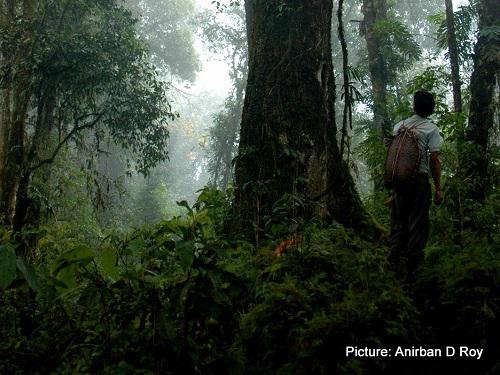Anirban Datta-Roy
The primary aims of this project are to demonstrate the importance of community managed forests in retaining endangered mammalian and avifauna within a biodiversity hotspot and to investigate the prevalent hunting practices among indigenous tribes and the spatial and temporal patterns associated with this activity.

Community forests around study village.
Hunting in tropical forests has been the subject of considerable research. Ecological research has focused on the effects of hunting on biological systems and the ecological implications of unsustainable extraction while anthropological studies have highlighted the role of hunting in cultural and livelihood related activities. There is a growing realisation of the need to gain a holistic understanding of local hunting in the context of biodiversity conservation that incorporates a cultural ecological perspective.

Mountains of Upper Siang.
Northeast India, part of the Eastern Himalayas is designated as a global biodiversity hotspot. This area lies adjacent to the Southeast Asian region and bears close similarities in tradition, ethnicity and culture with Southeast Asia. Hunting plays a major role in the lives of people here and wild animals are regularly used for food, rituals and medicine even though it is prohibited by law. Most of this hunting occurs in community managed forests and multiple use landscapes. The limited research addressing this has meant that the reasons behind its persistence are still poorly understood. It is an activity that has close linkages with the cultural and socioeconomic life of the people of this region, and requires a deeper understanding of the causal factors.
The study is located in the Upper Siang district of Arunachal Pradesh, an area of unique biogeographical significance which has seen limited attempts to document its flora and fauna. The proposed study aims to highlight the importance of community managed forests in harbouring a range of mammalian and avian fauna, even those which are subject to local hunting. In view of the increasing shift in focus from protected areas to multiple-use landscapes, such examples would add to a growing body of literature which highlights the need to look beyond protected areas for future conservation planning.
There is a significant dearth of knowledge on hunting practices of tribal people in northeast India. Most studies have focused on the effects of hunting rather than the causes. This study addresses this gap and uses a multidisciplinary approach to document and understand spatial and temporal patterns of local hunting. This will enable a holistic understanding of the motivating factors behind hunting as well as the methods and techniques that are employed by indigenous tribes in the study area. In the longer term, the project hopes to foster greater dialogue and cooperation between all concerned stakeholders, including local institutions and government bodies with regard to biodiversity conservation.